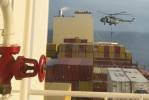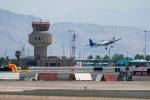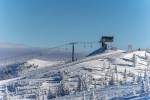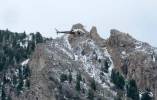Death of a hero
It had been snowing sporadically for two days when Western Air Express pilot Maury Graham set down here en route to Salt Lake City on Jan. 11, 1930.
Graham was a decorated World War I aviator and later brought the first airmail plane into Las Vegas. He was known generally as a thoughtful, cautious man. On the other hand, he also had a reputation among his peers as the guy who was always on time. Today, snow or no snow, he would continue his run to Salt Lake City.
Shortly after his Boeing 95 plane disappeared into the clouds, mechanics at the field heard an airplane engine overhead and thought it was Graham attempting to return to the airport. When he didn't, they concluded that he couldn't see the runway lights.
As all had feared, he failed to show up in Salt Lake City, and his friends and fellow pilots began a search that would last six months.
"One of the reasons for the prolonged search," said aviation historian Gary Kissel, "was that the people who knew him well, and especially his wife, would not believe that Graham had crashed and was killed. Instead, they believed that he set his plane down safely and was either waiting out the weather so he could take off again, or that he was injured in the landing and was waiting for help."
It was a harrowing search, given the rugged terrain and deep snow. The air route followed the Union Pacific Railroad in most places, but Graham's plane wasn't found along its tracks.
As the search intensified, 24 Army and Navy airplanes joined the effort, but were all grounded by another snowstorm Jan. 18. By the end of the month, the military planes had pulled out, and the search wound down.
But Graham's comrades, Fred Kelly and Jimmy James, refused to give up, and Western allowed them to continue their search as long as they continued their scheduled runs. The airline offered rewards ranging from $3,000 to $10,000 for Graham's recovery.
Meanwhile, the winter was shaping up as one of the worst in Western's history, in terms of safety.
Kelly, exhausted after over 150 hours in the cockpit, was hedge-hopping in the canyons near St. George when he scraped a wingtip on the ground and crashed. He walked away from the wreck to a highway, holding his head in his hands to support a broken neck. He was taken to a hospital by a passing motorist.
That same day, a WAE plane en route from Albuquerque, N.M., smashed into a mountain near San Bernardino, Calif., killing both pilots and a steward.
On June 24, two sheepherders finally discovered Graham's red and silver biplane in the Kanarra Mountains, 22 miles south of Cedar City, Utah. But Maury Graham wasn't with it.
The plane had evidently landed, but had damaged a wingtip and the landing gear. It appeared that Graham had attempted to walk out through the 8-foot snowdrifts.
Further examination determined that the plane had five gallons of fuel in its tank, meaning Graham had probably landed deliberately. He had removed the plane's tool kit and attempted to remove a section of the fuselage, possibly to use as a sled, but probably realized it was too heavy.
Melting snow had obliterated any track Graham may have left, so the searchers fanned out over a wide area. Three weeks after the plane's discovery, Graham's body was found about six miles from his plane, at the bottom of a sheer cliff overlooking Zion National Park.
Investigators believed he had sustained a head injury in the crash and had simply stumbled over the precipice. In his right hand, he had a revolver, with several empty casings, indicating he had attempted to signal for help. On his chest was his pocket knife, nearby, a half-opened can of food.
He was flown from Utah to Los Angeles in a Western Air Express Fokker Tri-Motor, and buried in Glendale, Calif.
Robert Griffith
The Stowaway
Part I: The Early Years
Part II: Resort Rising
Part III: A City In Full























